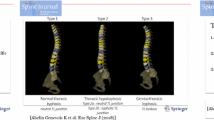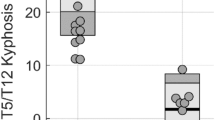Abstract
Purpose
In the last few years several reports stressed the importance of sagittal alignment in adolescent idiopathic scoliosis (AIS) patients. It was recently reported that T1 slope, defined as the angle between the superior endplate of T1 and the horizontal, correlates strongly with overall sagittal parameters. The aim of this study was to assess the impact of T1 parameters (T1-slope and T1-tilt) on sagittal alignment of AIS hypokyphotic patients preoperatively and postoperatively.
Methods
Twenty-nine AIS patients with <20° preoperative hypokyphosis were included in a retrospective study. Surgery systematically comprised hybrid construct with screws below T11, sublaminar bands at thoracic level and a lamino-laminar claw on the upper instrumented vertebra. Preoperative, postoperative and 2-year follow-up radiological assessment included Cobb angle, T1 slope, T1 sagittal tilt, regional sagittal parameters and pelvic parameters.
Results
In the series as a whole, coronal Cobb angle was significantly reduced postoperatively (58° vs. 17°; p < 0.001), thoracic kyphosis significantly improved (12.4° vs. 25.6°; p < 0.001) and cervical lordosis significantly restored (6.2° kyphosis vs. 4.1° lordosis; p < 0.001). There was a significant modification in T1-slope (10.2° vs. 18.2°; p < 0.001). Preoperatively, T1 slope was significantly correlated with T1 tilt (r = 0.427; p = 0.029). Postoperatively, T1 slope was significantly correlated with T1 tilt (r = 0.549; p = 0.002), thoracic kyphosis (r = 0.535, p = 0.005) and cervical lordosis (r = −0.444, p = 0.03). Restoration of cervical lordosis was significantly correlated to changes of T1-slope (r = −0.393, p = 0.032), which was significantly correlated to postoperative thoracic kyphosis.
Conclusion
According to these results, T1 seems to be of major interest in postoperative modifications of sagittal alignment. T1 slope and sagittal tilt are good indicators of postoperative changes for regional (cervical lordosis and thoracic kyphosis) and global parameters. We therefore consider these parameters as essential in the assessment of AIS patients. Further studies and correlation with clinical scores will, however, be necessary in order to confirm the present findings.


Similar content being viewed by others
References
Mac-Thiong JM, Transfeldt EE, Mehbod AA, Perra JH, Denis F, Garvey TA, Lonstein JE, Wu C, Dorman CW, Winter RB (2009) Can c7 plumbline and gravity line predict health related quality of life in adult scoliosis? Spine 34(15):E519–E527. doi:10.1097/BRS.0b013e3181a9c7ad
Schwab FJ, Blondel B, Bess S, Hostin R, Shaffrey CI, Smith JS, Boachie-Adjei O, Burton DC, Akbarnia BA, Mundis GM, Ames CP, Kebaish K, Hart RA, Farcy JP, Lafage V, International Spine Study Group (2013) Radiographical spinopelvic parameters and disability in the setting of adult spinal deformity: a prospective multicenter analysis. Spine 38(13):E803–E812. doi:10.1097/BRS.0b013e318292b7b9
Garbossa D, Pejrona M, Damilano M, Sansone V, Ducati A, Berjano P (2014) Pelvic parameters and global spine balance for spine degenerative disease: the importance of containing for the well being of content. Eur Spine J Off Publ Eur Spine Soc Eur Spinal Deform Soc Eur Sect Cerv Spine Res Soc 23(Suppl 6):616–627. doi:10.1007/s00586-014-3558-6
Benli IT, Ates B, Akalin S, Citak M, Kaya A, Alanay A (2007) Minimum 10 years follow-up surgical results of adolescent idiopathic scoliosis patients treated with TSRH instrumentation. Eur Spine J Off publ Eur Spine Soc Eur Spinal Deform Soc Eur Sect Cerv Spine Res Soc 16(3):381–391. doi:10.1007/s00586-006-0147-3
Hilibrand AS, Tannenbaum DA, Graziano GP, Loder RT, Hensinger RN (1995) The sagittal alignment of the cervical spine in adolescent idiopathic scoliosis. J Pediatr Orthop 15(5):627–632
Newton PO, Yaszay B, Upasani VV, Pawelek JB, Bastrom TP, Lenke LG, Lowe T, Crawford A, Betz R, Lonner B, Harms Study Group (2010) Preservation of thoracic kyphosis is critical to maintain lumbar lordosis in the surgical treatment of adolescent idiopathic scoliosis. Spine 35(14):1365–1370. doi:10.1097/BRS.0b013e3181dccd63
Knott PT, Mardjetko SM, Techy F (2010) The use of the T1 sagittal angle in predicting overall sagittal balance of the spine. Spine J Off J N Am Spine Soc 10(11):994–998. doi:10.1016/j.spinee.2010.08.031
Bennett JT, Hoashi JS, Ames RJ, Kimball JS, Pahys JM, Samdani AF (2013) The posterior pedicle screw construct: 5-year results for thoracolumbar and lumbar curves. J Neurosurg Spine 19(6):658–663. doi:10.3171/2013.8.SPINE12816
Akbar M, Dreher T, Schwab F, Omlor G, Wang H, Bruckner T, Carstens C, Wiedenhofer B (2013) Evaluation of the sagittal profile in patients with thoracic adolescent idiopathic scoliosis Lenke type 1 following posterior correction. Der Orthopade 42(3):150–156. doi:10.1007/s00132-012-2060-2
Okada E, Watanabe K, Pang L, Ogura Y, Takahashi Y, Hosogane N, Toyama Y, Matsumoto M (2015) Posterior correction and fusion surgery using pedicle-Screw constructs for lenke type 5C adolescent idiopathic scoliosis: a preliminary report. Spine 40(1):25–30. doi:10.1097/BRS.0000000000000652
Lowenstein JE, Matsumoto H, Vitale MG, Weidenbaum M, Gomez JA, Lee FY, Hyman JE, Roye DP Jr (2007) Coronal and sagittal plane correction in adolescent idiopathic scoliosis: a comparison between all pedicle screw versus hybrid thoracic hook lumbar screw constructs. Spine 32(4):448–452. doi:10.1097/01.brs.0000255030.78293.fd
Tao F, Zhao Y, Wu Y, Xie Y, Li M, Lu Y, Pan F, Guo F, Li F (2010) The effect of differing spinal fusion instrumentation on the occurrence of postoperative crankshaft phenomenon in adolescent idiopathic scoliosis. J Spinal Disord Tech 23(8):e75–e80. doi:10.1097/BSD.0b013e3181d38f63
Qiao J, Zhu F, Xu L, Liu Z, Zhu Z, Qian B, Sun X, Qiu Y (2014) T1 pelvic angle: a new predictor for postoperative sagittal balance and clinical outcomes in adult scoliosis. Spine 39(25):2103–2107. doi:10.1097/BRS.0000000000000635
Miyazaki M, Hymanson HJ, Morishita Y, He W, Zhang H, Wu G, Kong MH, Tsumura H, Wang JC (2008) Kinematic analysis of the relationship between sagittal alignment and disc degeneration in the cervical spine. Spine 33(23):E870–E876. doi:10.1097/BRS.0b013e3181839733
Ames CP, Blondel B, Scheer JK, Schwab FJ, Le Huec JC, Massicotte EM, Patel AA, Traynelis VC, Kim HJ, Shaffrey CI, Smith JS, Lafage V (2013) Cervical radiographical alignment: comprehensive assessment techniques and potential importance in cervical myelopathy. Spine 38(22 Suppl 1):S149–S160. doi:10.1097/BRS.0b013e3182a7f449
Ferrero E, Pesenti S, Blondel B, Jouve JL, Mazda K, Ilharreborde B (2014) Role of thoracoscopy for the sagittal correction of hypokyphotic adolescent idiopathic scoliosis patients. Eur Spine J Off Publ Eur Spine Soc Eur Spinal Deform Soc Eur Sect Cerv Spine Res Soc 23(12):2635–2642. doi:10.1007/s00586-014-3566-6
Sales de Gauzy J, Jouve JL, Ilharreborde B, Blondel B, Accadbled F, Mazda K (2014) Use of the Universal Clamp in adolescent idiopathic scoliosis. Eur Spine J Off Publ Eur Spine Soc Eur Spinal Deform Soc Eur Sect Cerv Spine Res Soc 23(Suppl 4):S446–S451. doi:10.1007/s00586-014-3341-8
La Rosa G, Giglio G, Oggiano L (2013) The Universal Clamp hybrid system: a safe technique to correct deformity and restore kyphosis in adolescent idiopathic scoliosis. Eur Spine J Off Publ Eur Spine Soc Eur Spinal Deform Soc Eur Sect Cerv Spine Res Soc 22(Suppl 6):S823–S828. doi:10.1007/s00586-013-3014-z
Jouve JL, de Gauzy JS, Blondel B, Launay F, Accadbled F, Bollini G (2010) Use of the Universal Clamp for deformity correction and as an adjunct to fusion: preliminary results in scoliosis. J Child Orthop 4(1):73–80. doi:10.1007/s11832-009-0221-6
Scheer JK, Tang JA, Smith JS, Acosta FL Jr, Protopsaltis TS, Blondel B, Bess S, Shaffrey CI, Deviren V, Lafage V, Schwab F, Ames CP, International Spine Study Group (2013) Cervical spine alignment, sagittal deformity, and clinical implications: a review. J Neurosurg Spine 19(2):141–159. doi:10.3171/2013.4.SPINE12838
Smith JS, Shaffrey CI, Lafage V, Blondel B, Schwab F, Hostin R, Hart R, O’Shaughnessy B, Bess S, Hu SS, Deviren V, Ames CP, International Spine Study Group (2012) Spontaneous improvement of cervical alignment after correction of global sagittal balance following pedicle subtraction osteotomy. J Neurosurg Spine 17(4):300–307. doi:10.3171/2012.6.SPINE1250
Van Royen BJ, Toussaint HM, Kingma I, Bot SD, Caspers M, Harlaar J, Wuisman PI (1998) Accuracy of the sagittal vertical axis in a standing lateral radiograph as a measurement of balance in spinal deformities. Eur Spine J Off Publ Eur Spine Soc Eur Spinal Deform Soc Eur Sect Cerv Spine Res Soc 7(5):408–412
Lee SH, Kim KT, Seo EM, Suk KS, Kwack YH, Son ES (2012) The influence of thoracic inlet alignment on the craniocervical sagittal balance in asymptomatic adults. J Spinal Disord Tech 25(2):E41–E47. doi:10.1097/BSD.0b013e3182396301
Jun HS, Jang IB, Song JH, Kim TH, Park MS, Kim SW, Oh JK (2014) Is it possible to evaluate the parameters of cervical sagittal alignment on cervical CT scan? Spine. doi:10.1097/BRS.0000000000000281
Blondel B, Lafage V, Schwab F, Farcy JP, Bollini G, Jouve JL (2012) Reciprocal sagittal alignment changes after posterior fusion in the setting of adolescent idiopathic scoliosis. Eur Spine J Off Publ Eur Spine Soc Eur Spinal Deform Soc Eur Sect Cerv Spine Res Soc 21(10):1964–1971. doi:10.1007/s00586-012-2399-4
Imrie M, Yaszay B, Bastrom TP, Wenger DR, Newton PO (2011) Adolescent idiopathic scoliosis: should 100 % correction be the goal? J Pediatr Orthop 31(1 Suppl):S9–13. doi:10.1097/BPO.0b013e3181fd8a24
Author information
Authors and Affiliations
Corresponding author
Ethics declarations
Conflict of interest
None.
Rights and permissions
About this article
Cite this article
Pesenti, S., Blondel, B., Peltier, E. et al. Interest of T1 parameters for sagittal alignment evaluation of adolescent idiopathic scoliosis patients. Eur Spine J 25, 424–429 (2016). https://doi.org/10.1007/s00586-015-4244-z
Received:
Revised:
Accepted:
Published:
Issue Date:
DOI: https://doi.org/10.1007/s00586-015-4244-z




